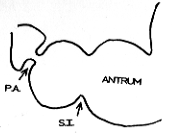


Go to chapter: 1 | 2 | 3 | 4 | 5 | 6 | 7 | 8 | 9 | 10 | 11 | 12 | 13 | 14 | 15 | 16 | 17 | 18 | 19 | 20 | 21 | 22 | 23 | 24 | 25 | 26 | 27 | 28 | 29 | 30 | 31 | 32 | 33 | 34 | 35 | 36 | 37 | 38 | 39
Chapter 2 (page 4)




Go to chapter: 1 | 2 | 3 | 4 | 5 | 6 | 7 | 8 | 9 | 10 | 11 | 12 | 13 | 14 | 15 | 16 | 17 | 18 | 19 | 20 | 21 | 22 | 23 | 24 | 25 | 26 | 27 | 28 | 29 | 30 | 31 | 32 | 33 | 34 | 35 | 36 | 37 | 38 | 39
Chapter 2 (page 4)
 | Fig. 2.3. Pyloric antrum according to Gray's Anatomy (American Edition). P.A., pyloric aperture; S.I., sulcus intermedius; P.V., pyloric vestibule; I.A., incisura angularis |
Different definitions of the pyloric antrum were encountered in the American and British editions of an anatomical textbook, both published in the same year. In the 29th American edition of Gray's Anatomy of the Human Body (l973) the antrum was said to be located on the caudal side of the sulcus intermedius, the latter being 2.5cm from the aperture (Fig 2.3); the pyloric vestibule was said to be on the oral side of the sulcus, extending to the incisura angularis. It was also stated categorically that the antrum was much smaller than the pyloric mucosal zone. In the 35th British edition of Gray's Anatomy (l973) the antrum was said to be on the oral side of the sulcus intermedius (Fig 2.4).
 | Fig. 2.4. Pyloric antrum according to Gray's Anatomy (British Edition). P.A., pyloric aperture; S.I., sulcus intermedius |
Strickland and Mackay (l973) again equated "antrum" with the pyloric mucosal zone.
According to Spiro (l977) the antrum was too loosely defined, but was usually considered
to be the portion of the stomach beyond the angulus. It differed from the remainder of
the stomach in that its motor activity was greater, its mucosa was different (being the
source of gastrin production) and it had an absence of mucosal folds (Comment: The
angulus, seen endoscopically, corresponds to the incisura angularis. Radiology shows
that mucosal folds are by no means absent in the normal living, distal stomach.)
Stave and Brandtzaeg (l978) considered the "distal" antrum to be the region extending
proximally from the pylorus for a distance of 3.0 cm. Polak et al. (l977), Royston et al
(l978) and Dockray (l978) equated "antrum" with the pyloric mucosal zone. According
to Ito (l98l) the antrum is proximal to the pyloric canal. (Comment: Ito's pyloric canal
would have been considered to be the terminal antrum by Stave and Brandtzaeg.)
Szurszewski (l98l) defined the antrum by drawing an imaginary line from the incisura
angularis to a point opposite it on the greater curvature; the region between the line and
the gastroduodenal junction was looked upon as the antrum (Fig. 2.5). The muscular
zone between the intermediate sphincter (sulcus intermedius) and the gastroduodenal
junction formed the terminal antrum. Bolondi et al (l984) considered the antrum to be the
region extending from the angulus to the pyloric aperture. The terminal antrum was
described as the immediate prepyloric region by King et al (l984). Ganong (l985) again
equated "antrum" with the gastrin secreting mucosal zone.
 | Fig. 2.5. Pyloric antrum according to Szurszewski. P.A., pyloric aperture; S.I., sulcus intermedius; I.A., incisura angularis; T.A., terminal antrum |
According to K.L. Moore (l985) the pyloric part of the stomach consists of a narrow
portion 1.0 to 2.0 cm long, which is continuous with the pylorus and called the pyloric
canal, and a wider pyloric antrum on the oral side of the canal.
Previous Page | Table of Contents | Next Page
© Copyright PLiG 1998